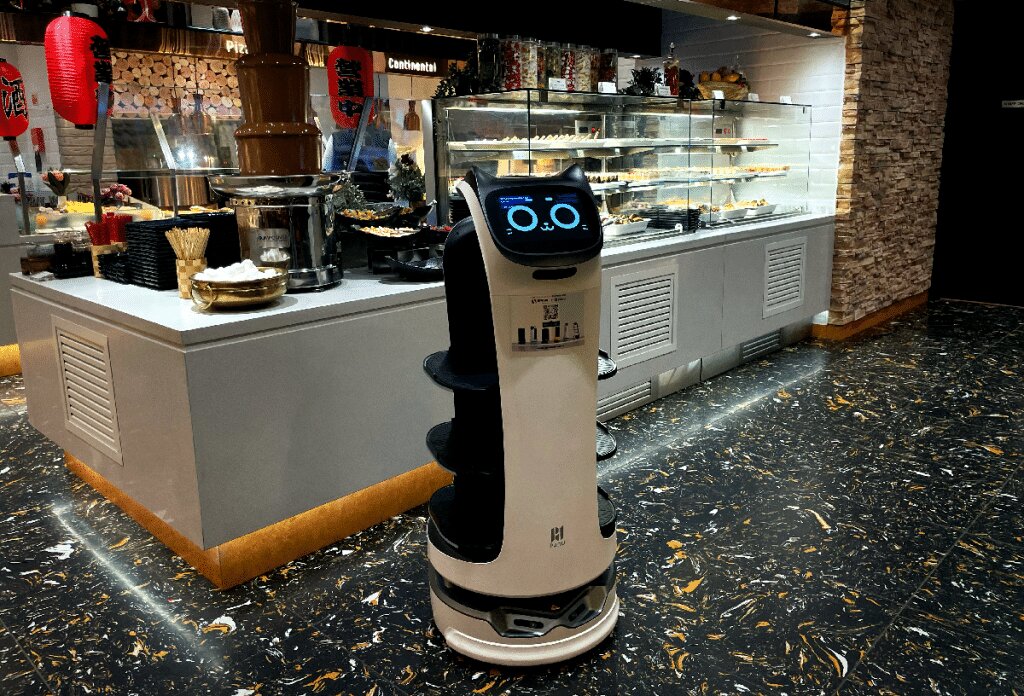Robotics, an ESG solution?




Synopsis
In the hospitality industry, the integration of robotics and ESG principles is gaining traction. While ESG focuses on sustainable practices, including workforce management, robotics offers solutions to labor challenges. This article delves into how robotics can enhance the 'Social' aspect of ESG within the EU hospitality sector. It explores the potential of robotics in improving workforce conditions, such as work-life balance and training opportunities, despite current limitations and cultural challenges in the industry. The piece also discusses the broader implications of ESG regulations on corporate behavior, emphasizing the need for a holistic approach where technology is guided by a commitment to employee welfare and sustainable practices.
Together with AI, robotics and ESG (Environmental, Social, and Governance) have gotten a lot of attention in hospitality; ESG is touted as the solution to all the sector’s sustainability challenges (in the broadest sense of the word), while robotics is often mentioned as the solution to labor shortages, high labor costs, low productivity and or a combination thereof. While both ESG and robotics will play a role in the abovementioned, they are not a panacea; often the expectations of the industry far outstrip what is realistically possible in the short term.
In this article, we will focus on the role robotics can play in improving the score of some labor key performance indicators linked to the S in ESG within an EU hospitality setting. We will explain both the basics of ESG and robotics, before we explain what the latter can do for the former.

Figure 1: Topics under ESG. (Source: Authors’ own)
ESG background
ESG, encompassing Environmental, Social, and Governance factors (See Figure 1), currently involves disclosing non-financial alongside mandated financial information. Companies with a subpar ESG profile, will increasingly face more problems with capital availability, higher capital costs and lower valuations, making ESG a matter of corporate survival. Particularly relevant to the hospitality sector is the European Sustainability Reporting Standards (ESRS) S1 under the EU’s Corporate Sustainability Reporting Directive (CSRD), focusing on 'Own Workforce' disclosures, involving aspects such as Secure Employment, Working Time, Adequate Wages, Work-life balance, and Training & Skills Development.
In an industry heavily reliant on labor, adhering to these standards can significantly affect an establishment's ESG profile. Interestingly, these aspects are also areas where robotics may offer innovative solutions. With developments in robotics, the hospitality sector has the potential to enhance its ESG strategy, affecting multiple aspects of workforce operations, which ultimately may have material consequences.
Robotics in hospitality
Ever since the 1950’s, robots have been taking over tasks in the manufacturing industry. This all started with the development of the Unimate robot. This machine was deployed in a General Motors car factory where it moved cast metal parts out of an oven that were often too heavy and too hot for human employees to handle. Robots are standard machines that, due to their generic design and great flexibility, can be programmed to perform a multitude of tasks. Robots are used to take over tasks that are too repetitive, heavy or precise for human employees to execute. Industrial robots come in two main types; robotic arms and AGVs (Automated Guided Vehicle). Robotic arms are often fixed in one place and execute repetitive actions. The most famous examples are the groups of robotic arms that weld together cars. AGVs, are wheeled carts that move autonomously through factory halls to transport items. Their design is often much simpler than that of the robot because their tasks consist of navigating autonomously through factory environments. AGV’s have also been introduced in hospitals where they transport items, a prominent example of this is Aethon’s TUG robot which can save a hospital multiple FTEs (Full Time Equivalent) because of its logistical capabilities.
First examples of robots have also been introduced in hotels and restaurants. The most effective robot to date is the restaurant robot that can transport items through hotel and restaurant venues. Research has already shown that introducing said robots can increase turnover for large restaurants. When employees direct these robots to a table, they will find their way there autonomously. They have an internal map of the restaurant floor and will stop when someone jumps in front of them.

Other robots that have penetrated the hospitality industry are interaction robots like Softbank’s Pepper. These robots can be used as concierges, to provide guests with information and to handle complaints.
It is expected that, just like in manufacturing, robots will take over a huge number of tasks in hotels and restaurants. However, there are big fundamental differences between factory and hospitality work environments. The biggest factor is the presence of guests. Guests are untrained to deal with robots and, should they have a bad experience, can choose not to return to the hotel or restaurant.
Other than in manufacturing contexts, where productivity and efficiency are often directly related to profits, in hospitality, it is the guest satisfaction that determines a big part of profits. The examples that are currently used in hospitality only take up a few distinct tasks.
So, for certain tasks, robotics can be used and thus potentially free up employees to be involved in more value adding tasks within the operations. It could also allow more time for further training and education of these employees. As several research papers have indicated, personal development & training are deemed one of the most important factors in job satisfaction. Furthermore, “greater autonomy and independence, greater power of decision making,..” are other factors with significant impact on job satisfaction. Wages are yet another factor, which in most surveys come forward as a reason for job dissatisfaction (i.e. wages being too low).
Robotics could therefore, theoretically, play a direct and significant role on 4 ESRS S1 sub-sub-topics: Work Time, Adequate Wages, Work-life Balance, and Training & Skills Development. For example, by reducing the number of menial tasks within an employee’s job, the job becomes more meaningful. Also, by freeing up time, there could be more room for training and skills development. Furthermore, this should allow the employee to be involved in positions with greater power of decision making and should allow the employee to become more productive, thus creating more room for wage and/or salary increases as the benefit of increased productivity can be shared between employees and employer.
Furthermore, an increase in productivity due to robotics could allow for a better work-time and work-life balance, as overworked employees can be relieved of certain menial tasks. This is an ideal scenario though, as current issues in hospitality also derive from the work culture, where employees are expected to work for long hours and low pay. It is not a given that robotics will alter this culture. Furthermore, this also assumes that the costs of robots do not outweigh these benefits of course.
Another possible advantage of robotics in this matter could be that the increased job satisfaction will reduce employee turnover. This will not only be an advantage to the employer (lower employee acquisition and retention costs, better and more consistent service levels), but also to the employees who will be able to build better and more meaningful relations with their coworkers.
As the paper of Peter Heimerl, Marco Haid, Lea Benedikt, Ursula Scholl-Grissemann brought forward, a positive relationship with a supervisor is yet another factor in job satisfaction, so having a lower turnover could, logically, lead to better relationship between supervisors and their employees. Although this does not directly relate to the ESRS S1 sub-topics and beforementioned sub-sub-topics, it can clearly cement these.
These advantages are easy to imagine, but to some extent, they are conceptual, and it might take years before actual competitive robotic alternatives will be available to the hospitality industry. The current examples of robots for
hospitality are still quite simple and not necessarily tailored to hospitality contexts.
One important thing to realize is that robots operate in the Sense, Think, Act paradigm. This means they take in sensory input from the environment and translate this into useful information. Then they determine what type of action to take and then act by performing this action in the physical environment. It is important to stress that two out of the three things that are key to robotic operations, the Sense and Act part, take place in a constantly changing environment with untrained guests that are not used to robots.
Successfully performing the Sense and Act actions are also highly dependent on hardware, where the Think part is dependent on software. Computational software has taken a flight in recent years with developments such as generative AI. For robots, updating software only takes a few moments, while updating hardware requires actually taking apart the robot and physically altering it. And automating tasks in hotels efficiently will most likely require new hardware for task execution that has not been developed yet.
Next to the technological hurdles that need to be overcome, there are also some organizational ones. It can be considered naïve if we expect all hotels to use the newly gained free time of their employees to invest in their training and guest connections. In an industry as competitive as hospitality, it might also be possible that hotel managers will adopt technology to simply be able to run operations with less employees.
Then there are also societal challenges that the automation of jobs in hospitality could affect. In general, automation does not decrease the number of jobs that exist, as when things get automated, new jobs become available in terms of manufacturing, maintaining or even selling the new technologies. However, it should be noted that this transfer of jobs is between uneducated and highly educated work. Many hospitality jobs provide essential employment opportunities for individuals with limited access to education. Subsequently, automation in this sector could offset societal benefits, potentially undermining the positive ESG impacts of robotics
Although robotic technology has the potential to solve many issues in hospitality, it might take years before its full potential is explored. The key will be the people who implement robotic technology; they must have the best interest of the hospitality employees at heart when implementing robotics and other forms of technology. Technology alone will not solve hospitality’s problems, people with the correct mindset will.
Perhaps that is where ESG disclosure regulations might foster this necessary mindset, but this will be achieved indirectly at best, as a good mindset cannot be mandated. But ESG reporting requirements will give capital providers (and other stakeholders) more insight than ever before into how well workers are treated by which hospitality companies, as this data has to be made public now. The increased transparency might thus lead to different corporate behavior as there will be financial consequences (higher cost of capital, lower availability of capital, reputational damage to name a few)
if treatment of the workforce is deemed subpar. ESG regulation could therefore indirectly affect corporate behavior.
Thus, while robotics might have replaced labor on the factory floor to save costs, within hospitality robotics might allow companies to score better on the ESRSs linked to its workforce, which will allow companies to reap beforementioned financial benefits. In that respect, the usual purpose of robotics to save labor costs, might actually be turned on its head by ESG regulations.
As stated before, it is still early days though, both concerning robotics development and ESG disclosure effects within the hospitality sector, but some optimism about the long-term effects of both might be warranted.